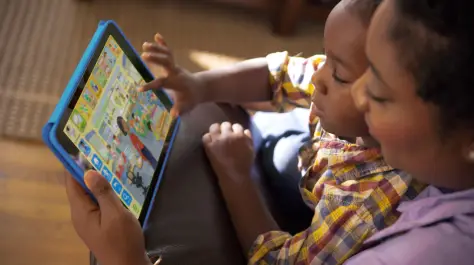Is your child’s school closed due to the coronavirus outbreak? Do you suddenly find yourself an accidental homeschooler and don’t know where to begin? Setting up an at-home learning environment is easier than you may think. I’m writing this on behalf of the Curriculum Team at Age of Learning, the creators of ABCmouse. We’re a group of over 20 educators who spend all of our time at work thinking about teaching and learning, and how to help each individual child thrive. Many of us are parents of young kids, too, and we’re facing the same challenges with the coronavirus outbreak as many other people in the U.S. and abroad. These challenges include dealing school closures and kids who are now at home for an indefinite amount of time. We’ve come up with some ideas based on educational research and best practices, and I thought it might be helpful if we shared a few of them. The most important thing to remember is that minutes matter in the educational lives of young children. Every minute passed is a minute your child will never get back. Kids are primed and ready to learn, and there’s a lot you can do with what you already have in the house to keep your child’s mind active.
People throughout the U.S. and abroad are being impacted by this, whether they are rich or poor; urban or rural; a celebrity or an everyday parent. No matter who you are or where you live, be sure to read, read, read, and talk, talk, talk with your children. Here are some other ideas that will keep the learning going during this challenging time.
Set a Routine
First, routine is critical. Kids in their early years thrive on routine, and they most consistently get this in school. It’s important to establish a daily routine while your child is at home and to follow it. Set times for reading, math, snack time, lunch, and even free play.
Keep a Journal
Encourage your child to write down what they see, hear, think, and feel briefly each day. If your child isn’t ready to write independently, have him or her dictate their thoughts to you. Any subject is fair game, whether or not it relates to the coronavirus. You’ll be making a lot of memories together during this time, and written recordings of them will become treasures for you and your child later on in life.
Start a Pen Pal Program
Kids love to get mail. Because contact with other kids may be limited, consider starting a pen pal program with classmates, family, and other friends. They can send their letters by email or by good old-fashioned snail mail. And, not only do kids get the benefit of writing, they’ll also love practicing reading when they receive letters from their pen pals!
Tell a Shared Story
Work together to make up a fun story. Begin a with an opening like “Once upon a time, there was a hungry frog.” Then ask your child to say the next sentence. Continue taking turns adding to the story until it is finished. This is a rich literacy and language-development activity that’s bound to bring big laughs. And when you’re done, you can create illustrations that bring the story to life.
Practice Measurement
Before kids learn about standard units of measurement, like inches, feet, pints, and gallons, they can begin to understand the concept of measurement using non-standard units. Use shoes to measure the distance across a room (How many shoes does it take to cross the room?) or pencils to measure the length of a table. Use different sizes of cups and glasses to fill a large bowl or bucket with water. Then talk about how the size or the cup or glass affects the number of times you use it to fill the bowl or bucket.
Work with Patterns
We’re most familiar with visual patterns—patterns of shapes, sizes, or colors, for example—but patterns can also involve sounds or movements. Work with your child to identify the next item in a pattern you start, or alternatively have him or her start patterns for you to continue. Here are a few examples: Visual Patterns
- Small, large, small, large
- Red, red, blue, red, red, blue
- Circle, square, triangle, circle, square, triangle
Sound Patterns
- Snap, snap, clap, snap, snap, clap
- Long sound, short sound, long sound, short sound
Motion Patterns
- Sit, stand, sit, stand
- Arms up, arms out, arms down, arms up, arms out, arms down
Sort, Count, Compare
Provide your child with a pile of objects that includes different colors, shapes, or sizes, such as buttons, paper clips, or blocks. Ask your child to sort the objects, count how many are in each group, and order the groups from fewest to most. Challenge your child to find other ways the objects could be sorted. As an edtech company, we’re excited to do what we can to help everyone make the best of this unprecedented situation. And we’re here to tell you that you can do a lot to for your children during this time. Take a deep breath, do a little prep, and good luck!
Our Digital Learning Programs
Lastly, if you’re looking for educational screen time, we are providing free access to our award-winning digital library, ReadingIQ. Use the code LOVEREADING. You can also sign up for ABCmouse and Adventure Academy, or get free access through your school district. — Joel Kupperstein, SVP Curriculum at Age of Learning
